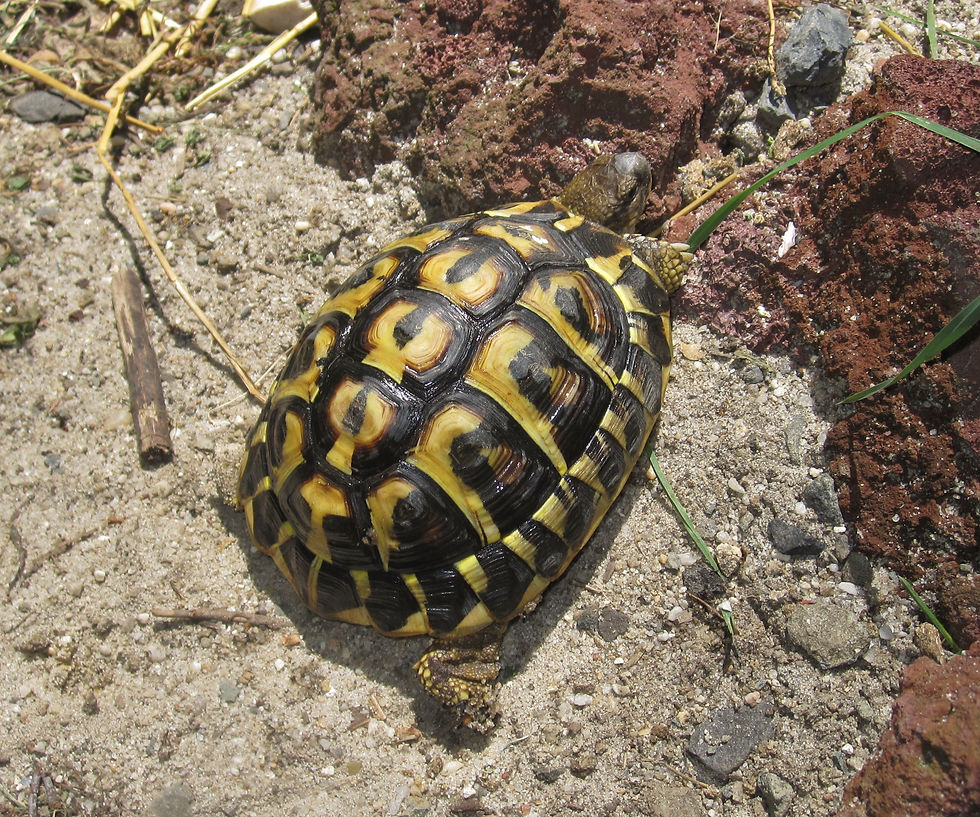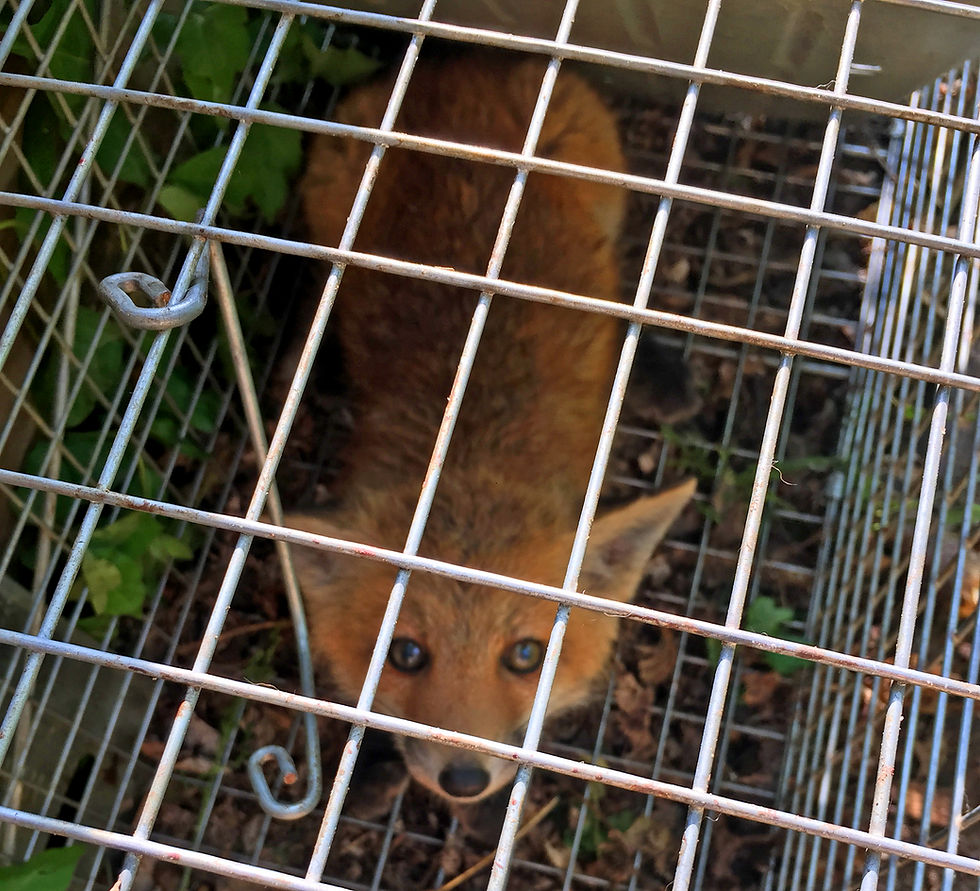Protecting Turtles & Tortoises From Predators
- ChrisLeone

- Feb 21, 2021
- 6 min read
While outdoor housing has its great benefits, it also comes with one major set-back. Predators are a very real issue for turtles and tortoises living outside without the protection of a home or building.


Raccoons are of course the number one threat to outdoor chelonian collections but mink, rats, voles, coyote, fox, raptors and even ferrel dogs and cats are all potential killers. Crows in particular learn to recognize nesting females and will rapidly make a meal out of the eggs as they are being laid. Skunks and fox love to unearth nests and devour the eggs. Most attacks from predators occur at night or when the keeper leaves for several days. Some of these animals are highly intelligent and able to learn quickly when a human’s presence is no longer near. Raccoons have been known to annihilate a group or collection of turtles or tortoises in just one night, so it is especially important to have methods in place to deter them. Even some larger species may be at risk to them especially when they're in a younger, smaller stage. Voles love to eat babies and although not always an immediate threat, raptors such as hawks, eagles and owls have been reported to make off with one they can easily carry in their talons.

We prefer to house the vast majority of our collection outside year-round, so we have made sure to equip the entire property with not one, but several predator deterrents. It’s unclear which of these methods works best because we always have all of them in place at the same time, but the absolute truth is that animals are staying out of our pens to date.

Electric fencing is a very effective method. We use American Farm Works electric fence controllers with 1.2 output joules that are good for 30 miles. This emits a painful, powerful shock. Both AC and solar powered units are available. Our fences are turned on at sundown and turned off at sunrise. The wire is run at a specific height and distance from the enclosure so that an animal must hit it if it tries to enter. As a father with young children, I recommend making sure the fence is shut off before allowing them anywhere near it. Some people have asked us questions like, “Isn’t the electric fence kinda harsh on the animals that might try to come in?” My answer is, “Umm, yes, that’s the point.” We are the ones who choose to keep turtles and tortoises, therefore we should vow to protect them through any measure possible. To watch a video I made on how to install the electric fence, CLICK HERE

Yard Sentinel makes an interesting product that acts as an ultrasonic pest repeller. These small green units are mounted on a tree or enclosure wall at different heights depending on what you want to repel. For raccoons, we mount them roughly 15” from the ground and for raptors, 8 to 12 feet high. On the back of the unit is a dial which allows you to set it to a fixed frequency based on the predator you mostly want to deter. Several units can be installed around the yard, as we have done, and set to keep out various predators. Some are set to raccoon while others are set to raptors, so on and so forth. Yard Sentinel repellers can also be set to run on a constant loop or only come on at sundown. They then turn themselves off at sunrise. If your property is in very close proximity to a neighbor, you may want to make sure with them first that it does not irritate their ears. Some people can hear the sonic frequencies well while others do not seem to care. The units do not bother the turtles and tortoises.

Nite Guard makes neat little solar powered black boxes that are mounted on trees or enclosure walls. They act as simple red blinking lights, that run all night, to mimic the appearance of an animal’s eyes. The objective is that Nite Guard’s blinking red lights let a predator that may looking to enter the premises think that something is already there and that it may pose a threat.
Motion sensors work as a way to tell animals they’ve been spotted. Depending on the size of the animal and where the sensor is, the motion of it walking by sets off a bright light. This may send an illusive predator running for the hills.


Have-a-Heart traps can be an excellent way to humanely capture predators for release elsewhere. These traps come in various sizes but are a bit pricey. By using the right bait, a predator nearby will pick up the scent of it instead of the sleeping chelonians and get stuck in the trap. For raccoons, we’ve found that bluefish heads, discarded lobster parts, chocolate chip cookies and plain old aquatic turtle pellets (or koi food) work to draw them in. You’ll also draw the attention of skunks and possums, so keep that in mind. It’s also worth mentioning that by using bait, you could potentially be attracting predators that weren’t previously interested in your yard. When releasing these animals, take them a considerable distance away because they can and will find their way back. We choose to take raccoons 30 to 50 miles away if we catch any.

Decoys can be used but it’s assumed that animals get used to them quickly. Perhaps moving them around the premises will help to continue to fool them. Owl decoys, coyote and dog decoys are available as well as “halloween crows”. These cheap, plastic, feathered fake crows can be strung around in trees to deter live crows looking for tortoise eggs. Crows are surprisingly smart and may recognize these strung up fake ones as dead members of their own kind. This alarms them and alerts them to stay away.

Since crows and other larger birds can pose an immediate threat to smaller turtles, tortoises and their eggs, you can construct a netting out of 100 to 200lb test fishing line and some posts. The birds will fly downward and hit the line and then bounce off it. This freaks them out and sends them not only fleeing but they call out to their flock (crows in particular) to let them know it's not safe. To watch a video I did on how to make this, CLICK HERE.

Cameras go a very long way in at least letting you know what is going on at any time. They may not stop a natural predator but their presence may keep out human thieves. Turtle and tortoise collections are very valuable and in the case of some species being so hard to obtain, all it takes is one indecent human-being getting wind of your location and you may find yourself “turtle or tortoise-less”. We make use of Arlo systems. They are attractive little wireless cameras for both indoor and outdoor use. The base unit hooks up to WiFi and an app is downloaded to your smart phone. You can then watch your cameras from anywhere and have them set to motion so that they alert your phone when something has come into focus. They also record. The base units allow multiple cameras depending on what service option you choose to purchase and all of them can be viewed on your phone. This is also a great way to make sure you aren’t missing nesting females as they lay their eggs and disguise them from view. These systems really give us peace of mind because we can see our animals 24/7 if we want, even when we’re far away on family vacations. Various eye-catching signs can be bought online with sayings such as, “Smile, you’re on camera!”, or “Warning: area under 24 hour surveillance”. We place these around our entire property to let potential trespassers know that we can actually see them, even if we aren’t home.

Lastly, a highly effective method of keeping anything or anyone out of your chelonian enclosures is by having a large dog, or several dogs. Not everyone is a dog person, and although we can’t imagine our life without them, I get it. But, a large, powerful dog, trained to protect your animals and the property is without a doubt an excellent deterrent that sincerely gives peace of mind. Our big guy knows what he has to do and they are of course his turtles and tortoises.

As already mentioned, it’s difficult to claim which of these methods or which combo of them works best. Because we work with our animals daily and they are our life, we make use of this wide variety to really make a solid effort in keeping all harm away. We also live backed up to 47,000 acres of protected wildlife refuge, so, predators are certainly out there, lurking. It wouldn’t be wise to let our guard down, needless to say. Take this very seriously. I can’t tell you how many horrific stories I’ve heard through the community and friends who have lost beloved turtles and tortoises to these very real threats. These wild animals are only doing what they know best and it is us that has encroached on their territory. They have to survive and they will stop at nothing to get a meal, unless we take the proper, responsible precautions.
Chris

32
312
321
This article on protecting turtles and tortoises in outdoor enclosures was very helpful Chris. Although I have kept both turtles and tortoises my whole life, I’ve never done so outside. After following you on YouTube, you inspired me to try it out. There’s a lot of interesting points that you pointed out that will definitely help for keeping these animals outside. I love what you do. Keep making these videos and articles and we’ll keep watching.
Thank you,
Ryan Costa